
PREV ARTICLE
NEXT ARTICLE
FULL ISSUE
PREV FULL ISSUE
SELECTIONS FROM THE MARCH 2017 KAGIN'S SALEYes, I know this sale is over now and it's too late for people to bid. But I thought there were some interesting pieces here and wanted to write up anyway. -Editor
Lot 1018: 1783 Treaty of Paris Medal
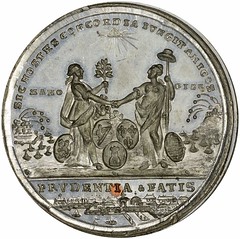 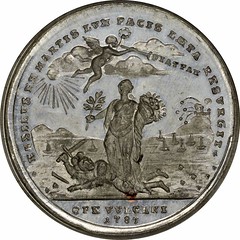 This medal was struck to commemorate the 1783 Treaty of Paris. The treaty formally ended the American Revolutionary War between the United Kingdom of Great Britain and the United States of America that had rebelled against their rule starting in 1775. The obverse depicts Peace with an olive branch greeting America who holds a pole with Liberty cap; at their feet are shields of Great Britain, France, Spain and the Netherlands. In the exergue is the legend PRUDENTIA-FATIS (By Prudence and the Fates). On the reverse Peace tramples on War lying prostrate with a broken sword in his right hand. There's a LOT going on in this medal design. There are many far more expensive items in the sale, but this is a beauty. Great historically important piece. -Editor
To read the complete lot description, see:
Lot 1025: John T. Waterhouse Hawaii Token
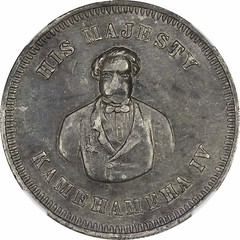 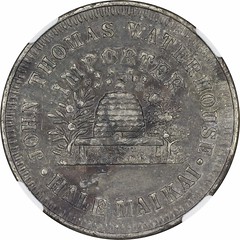 Hawaii Token. Undated (1855-1860) John T. Waterhouse. 2TE-1. Lead. Reeded Edge. AU-50 NGC. Deep steel gray throughout with marginally lighter high points. Obverse: facing bust of king, HIS MAJESTY arcs above, KAMEHAMEHA curves below. Reverse: industrious bee hive at center, rose bush to viewer’s left, fruit tree to right, JOHN THOMAS WATERHOUSE arcs around, HALF MAIKAI curves below. Some light marks are present as befits such a soft composition. A rare prize from the expanding field of Hawaiian token collecting. This is why coin designers rarely use a full front view of a person's face - the nose becomes the high point and gets all the wear, and it doesn't take much to wear down a
soft lead token. The guy looks like Jimmy Cagney shoved a grapefruit in his face, even though the rest of the piece shows little wear. A rare item of Hawaii exonumia, and highly collectible.
-Editor
To read the complete lot description, see:
Lot 1625: C. Bechtler $5 Gold
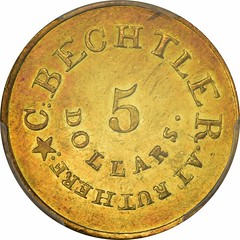 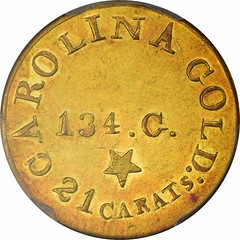 Undated (1834). C. Bechtler $5 Gold. Kagin-20. Rarity-5. With 134 G., Star. Plain Edge. Prooflike. MS-61 PCGS. Brightly reflective yellow gold surfaces and frosty patches of warm sunset orange offer up a visual treat for an attentive specialist. Other than some hairlines, you won’t find any serious blemishes hiding here. Though not called “prooflike” by PCGS, it is undeniably that in our estimation, including some rather deep mirror surface at the obverse rim. As elsewhere in the Bechtler series, the Rarity-5 rating given to Kagin-20 is misleading; it refers to the numerous circulated examples of the variety that buoy the reported population. In Mint State, Kagin-20 is a dynamic rarity in its own right. Indeed, the present specimen is tied for finest seen by PCGS, and in our opinion it is the second-finest example of the variety extant. This important Allan Collection Bechtler $5 should bring out the best among the many competitive specialists who will no doubt have this coin high on their want list-wish list. Our only advice is to be prepared at bidding time! Obverse: CAROLINA GOLD: at rim from 8 to 4 o’clock around, 134.G. at center, inverted five-pointed star beneath, 21 CARATS curves at rim beneath star. Reverse: C: BECHTLER: AT RUTHERF: and star around, 5 at center, DOLLARS. curves below. Die Alignment: about 250 degrees. PCGS Population: 2; none finer.
I've always enjoyed the southern states private gold issues, and this is a great example. The sale also includes many lots of interesting counterfeits of these issues.
-Editor
To read the complete lot description, see:
Lot 1675: $10 Die Trial on Classic Head Cent
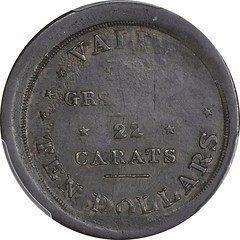 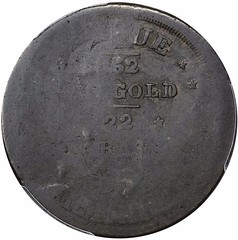 Undated (circa 1849) $10 Die Trial on Classic Head Cent 1810-1814. VF-30 PCGS. K-1 (p.357 of Private Gold Coins and Patterns of the United States) 153.2gr; 30mm. 270 degree turned) Deep chocolate brown throughout. Many of the host coin’s details show including 1814 date. Unevenly struck on both sides from by the same die but more forcibly on the cent obverse than the reverse. Stylistically of the same non-descript tenor generally attributed to the early Gold Rush era, but without manufacturer’s identification. Weakly struck in areas. Obverse: VALU(E) arcs above, TEN DOLLARS curves below, 3 stars to left, 1 (of 3) to right, 2?? / GRS. ??? / 22 with star to each side / CARATS at center on four lines. Reverse: another impression of the obverse reading (VAL)UE at top, 262 / (G)RS GOLD / 22 with star to each side / CARATS – between the two impressions the entirety becomes clear. The coin is generally similar in appearance and design to the Bechtler coinage and to a pattern also struck on an 1841 Large cent by Bechtler friend and executor, Heinrich Schaeffer (see pages 83 and 357 of Don Kagin’s book, Private Gold Coins and Patterns of the United States). However the punches are not an exact match. It is quite possible that either Schaeffer or another coiner experimented with striking coins during our nation's second gold rush in California. We are not certain at all of the origins of this piece but can posit some reasonable speculation. This specimen first came to our notice as part of the noted Western historian and pioneer gold specialist, Henry Clifford’s collection. According to his records, Clifford acquired it 9/12/1957 from numismatic curator, Dr. T.V. Buttrey of Yale University. When Clifford’s non-gold pioneer coinage collection was sold by Bowers & Ruddy Galleries (3/82:118), it was purchased by numismatist John J. Ford. Stacks later sold this piece in one of the celebrated Ford sales (9/13:10103) where it brought $17,625 after fierce bidding. Extremely Rare, intriguing, and unusual, and a numismatic item that has the power to enthrall territorial gold specialists, Bechtler gold and large cent enthusiasts alike. I checked with Ted Buttrey (who is with the Fitzwilliam Museum in Cambridge) about the piece. -Editor
Dr. T.V. Buttrey writes: This is untrue. I have never had anything to do with this piece. I did not know Clifford and never did any business with him -- nor with anyone else for that matter. To read the complete lot description, see:
Lot 1684: 1860 Clark, Gruber & Co. Gold $2.50.
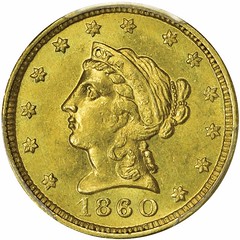 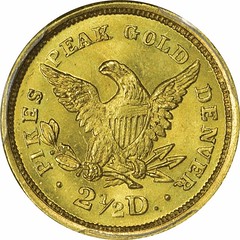 A real beauty! -Editor
To read the complete lot description, see:
Lot 1720: 1853 Round Half Dollar, Arms of California
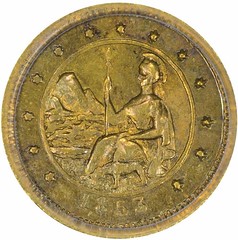 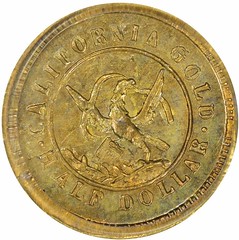 1853 Round Half Dollar, BG-435, Arms of California. MS63 PCGS. Arms of California, 13 tiny stars around, date below; eagle with shield, CALIFORNIA GOLD/ HALF DOLLAR around. Unique designs make this a key to any type set of small California gold. Maker unknown (“Unknown Maker A”). In the second edition of California Pioneer Fractional Gold this cataloger speculated that BG-435 might be the work of San Francisco manufacturing jewelers Braverman & Levy, who did business under this style from 1852 through 1881. George Ferdinand Albrecht Küner, engraver of the Great Seal of California (and also the dies for many of the larger private gold coins of California), worked in Braverman & Levy’s store from the spring of 1852 until the spring of 1854. While the dies for BG-435 are not his work, an impression of the seal he engraved may have been displayed in their show window and perhaps featured on their sign in 1853—a visual indication of the issuer. Merely Rare, but brings far in excess of most rarer issues because of demand from type set collectors. Lovely blue circular (“album” type) toning on obverse highlights the California arms, faint bluish cast with gold highlights covers reverse A standout of the series in terms of design. Nice coin. -Editor
To read the complete lot description, see:
Lot 1721: 1854 Round Half Dol., BG-436. Die State II
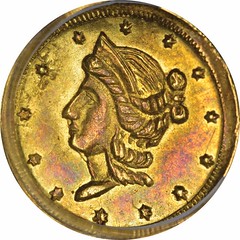 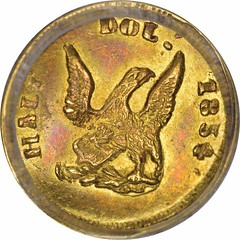 Bob Leonard was one of the cataloguers for the sale, and I asked him to tell us about his favorite piece. -Editor
Bob writes: My favorite is lot 1721, an 1854 round half dollar with eagle reverse, BG-436. BG-435 gets all the attention because of its unique design (Arms of California), but its late appearance has always troubled me (unknown prior to 1877). While BG-436 is not presently attested until 1883, it is more in line with the others of this period. This odd piece (the eagle lacks a scroll) was probably made by Auguste Dubois (at least four variant spellings), in a secret room in the cellar of a house with all the windows blacked out except one, at the southeast corner of Green and Fayette streets in San Francisco. Mr. Dubois had a partner who was either named Waschwald or Oswald (sic!! both names given in contemporary accounts). When visited by the police, Dubois explained that he was not a counterfeiter as they supposed, but a maker of gold pens. But since he appeared to have the equipment necessary to strike gold half dollars, my supposition was that he tried his hand in 1854, but with little success. This exact coin was in the outstanding collection of Jack Totheroh, co-author of the second edition of Breen-Gillio, California Pioneer Fractional Gold. I had the pleasure of cataloging it for Don Kagin in 2013. 1854 Round Half Dol., BG-436. Die State II ("period" die defect after date, "exclamation point" defect above period after DOL.) MS61 PCGS. Unusual Liberty head with coarse curls and hollow neck, 13 stars around; eagle with shield and branch, but no scroll (!), HALF DOL. around 1854 . A somewhat amateurish effort by an unknown maker (“Unknown Maker B”). Perhaps the work of Auguste Dubois, as surmised by the cataloger in the second edition of California Pioneer Fractional Gold. (His name is spelled “Auguste Duboice” in the San Francisco Herald; “Augustine Dubois” in the Sacramento Daily Union; “Augustin Dubois” in the Placer Times & Transcript (the latter two citations courtesy of indefatigable Gold Rush researcher Dan Owens); and “A. Duboce” in LeCount & Strong’s San Francisco City Directory for the year 1854. Mr. Dubois, who had a partner named John Waschwald or Oswald, operated out of a house on the southeast corner of Green and Fayette Streets with all the windows blacked out except one. The pair were accused of counterfeiting, and when this house was searched by the San Francisco police, a secret room was discovered in the cellar that held a rolling machine, furnace, crucibles, and a large amount of melted gold. When they returned to it, Auguste and John were arrested, but made bail and the charges were dismissed as false three days later. Mr. Dubois stated to the police that he had been a gold pen maker in New York, where he was from, and that his equipment was used for that purpose. While that may have been his intention in coming to California, upon seeing small California gold in circulation he was probably tempted to join the party, since he had all the necessary equipment (except a screw press, and he probably had that also but omitted in the newspaper accounts). In any case, there seems to be no other suitable candidate for a maker for the year 1854 only. To read the complete lot description, see:
Lot 1810: 1946 United Nations Monetary Patterns
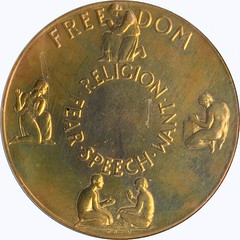 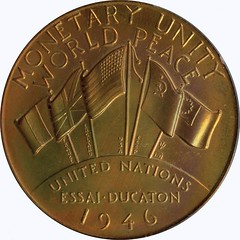 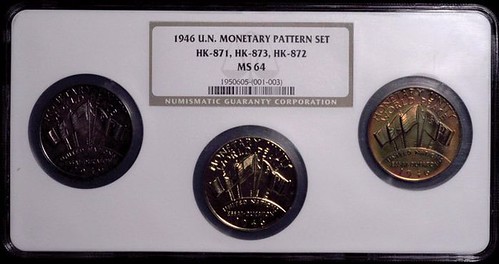 A 3 piece Set of 1946 United Nations Monetary Patterns, made in Gold, Silver and Bronze. HK-871,HK-873,HK-872. MS-64 NGC. Conceived by numismatists Abe Kosoff and Hans Schulman as a UN based, universal currency several decades before the Euro. The design was a 1-ducat (U.S. dollar) sized coin, only to be used as the initial pattern to spark interest in the idea. In 1946 the Medallic Art Company of New York, struck only 313 specimens in 23.95 karat Gold, and 1,000 each in Silver and Bronze. When the UN failed to adopt the plan, the dies were quickly destroyed. The obverse of the coin portrays flags representing the five nations appointed to the UN Security Counsel at the time. The design of the reverse is that of US President Franklin Roosevelt’s emblematic vision of the Four Provincial Freedoms: Freedom of Religion, Freedom from Want, Freedom of Speech and Freedom from Fear. A majority of the gold specimens were melted during the peaking gold market in the 1980s leaving only a couple of dozen or so available. Ex: Abe Kosoff. A great set; rare and interesting. I've read about these, but have never seen examples in person. -Editor
To read the complete lot description, see:
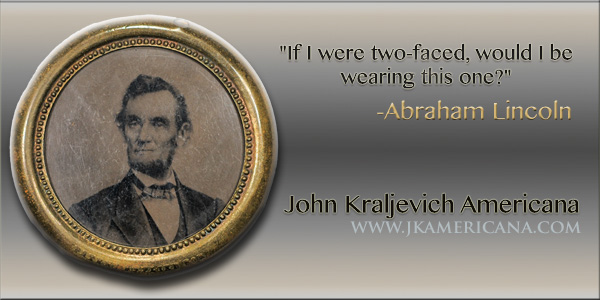 Wayne Homren, Editor The Numismatic Bibliomania Society is a non-profit organization promoting numismatic literature. See our web site at coinbooks.org. To submit items for publication in The E-Sylum, write to the Editor at this address: whomren@gmail.com To subscribe go to: https://my.binhost.com/lists/listinfo/esylum All Rights Reserved. NBS Home Page Contact the NBS webmaster 
|